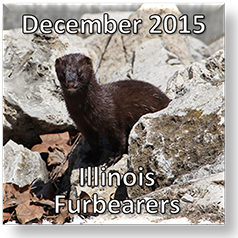
There are about 60 species of wild mammals in Illinois. What is a mammal? It's an animal with four limbs (legs/arms). It has hair or fur. It is warm-blooded (its body temperature is kept at the same level instead of being controlled by the environment). Most female mammals bear young that develop in a special organ, the uterus. Two species of mammals lay eggs, but they do not live in Illinois. After birth, mammal young are fed with milk produced by the female's mammary glands. Mammals have a large and complex brain. Wild mammals in Illinois include the marsupials (Virginia opossum), insectivores (shrews and moles), bats, rabbits, rodents, carnivores and ungulates (white-tailed deer).
"Furbearer" is a term used mainly by wildlife biologists to describe mammals that are hunted or trapped, usually for their valuable fur. There are 14 species of furbearers in Illinois. To some people, trapping, hunting and the use of fur are controversial issues. Here are some facts to help you understand hunting and trapping of furbearers.
- Hunting and trapping are highly regulated. More than 75 state, federal and international laws apply to the hunting and trapping of furbearers in Illinois. These laws provide standards for animal welfare, require licenses and training and set limits on hunting and trapping so that populations remain healthy.
- Furbearers are common species. As of 2016, it will be legal to hunt or trap all 14 species of furbearers in Illinois. Thanks to conservation efforts, some species once considered rare in Illinois are now thriving. Examples include the American beaver, North American river otter and bobcat. Most of the species that are hunted or trapped in Illinois are capable of giving birth to and raising many young in a short period of time. Even with diseases, predators and other factors causing death, many individuals remain that can be harvested by hunting or trapping.
- Society benefits from responsible harvest of furbearers. Regulated hunting and trapping help to keep furbearer populations at acceptable levels, reduce property damage caused by furbearers, raise funds for the conservation of wildlife, and provide a wide range of materials and products for human use, including but not limited to, fur garments, soap, pet foods, livestock, feed, paint, tires, textiles and construction materials.
Several publications from the IDNR can provide you with more information about hunting and trapping. You will find all of them through the
publications order form.Fur Hunting and Trapping brochure
Fur Hunting and Trapping DVD
Illinois Furbearers poster
Illinois Digest of Hunting and Trapping Regulations book
There are 14 species of furbearers in Illinois. They represent several types of mammals.

